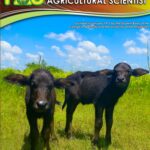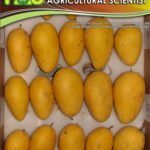Vol. 105, No. 2 (https://doi.org/10.62550/RI0610502)
Carrot remains one of the priority vegetable crops of the Philippines, according to the Philippine Statistics Authority (2020), with the Cordillera Administrative Region as the major producer in 2016 contributing 88.9% of the commodity in the Philippines. In the field of plant tissue culture although carrot somatic embryogenesis has extensively served as a model system for early plant development for over 50 years, the illustrations and drawings depicting the various stages in many literatures has remained incomplete. It is with the current journal article that the “triangle stage” was clearly and definitively documented using the modified protocol.
{Photographs courtesy of Mr. John Llloyd Talosig, Human Resource Management Section (HRMS), Forest Products Research and Development Institute (FPRDI) - Department of Science and Technology (DOST), Forestry Campus College, Los Banos}
Categories
Articles
Coccoidea (Hemiptera: Coccomorpha) Infesting Coconut Infructescence in The Philippines
Ireneo L. Lit, Jr., Merdelyn T. Caasi-Lit, Cristian C. Lucañas, Whizvir O. Gustilo, and Kristine O. Abenis
Received: May 21, 2021/ Revised: February 25, 2022/ Accepted: April 28, 2022
(https://doi.org/10.62550/EK059021)
During a series of field surveys on several coconut-planting provinces in the Philippines, scale insects, including mealybugs, were observed to attack the infructescence and fruits of coconuts, Cocos nucifera L. (Arecaceae). Three families of Coccomorpha, composed of six species of Diaspididae (armored scale insects), including the serious pest Aspidiotus rigidus Reyne, one species of Pseudococcidae [the mealybugs, Nipaecoccus nipae (Maskell)]; and one species of Monophlebidae (giant or cottony cushion scales, Icerya sp.), were noted to attack on coconut infructescences. Two species, Aspidiotus destructor Signoret and Lepidosaphes sp. aff. tapleyi were observed to feed on the fruit direct...
During a series of field surveys on several coconut-planting provinces in the Philippines, scale insects, including mealybugs, were observed to attack the infructescence and fruits of coconuts, Cocos nucifera L. (Arecaceae). Three families of Coccomorpha, composed of six species of Diaspididae (armored scale insects), including the serious pest Aspidiotus rigidus Reyne, one species of Pseudococcidae [the mealybugs, Nipaecoccus nipae (Maskell)]; and one species of Monophlebidae (giant or cotto...
Spatial Distribution of Unaspis mabilis Lit & Barbecho (Hemiptera: Diaspididae) in Lanzones (Lansium domesticum Corrêa) Trees in Aklan, Philippines
Ronelo S. Salaver, Evelyn P. Vedasto, and Michael T. Ibisate
Received: August 14, 2021/ Revised: January 20, 2022/ Accepted: April 27, 2022
(https://doi.org/10.62550/HR096021)
Unaspis mabilis Lit & Barbecho (Hemiptera: Diaspididae) adversely affects lanzones production in the Philippines. Characterized as having an aggressive behavior, this leaf-inhabiting species spreads fast and is difficult to control. Since its identification in 2014, it has already reached different parts of the country causing significant damage. Spatial distribution of U. mabilis in lanzones and the effects of weather on its population density were investigated for six months from November 2018 to April 2019 in two orchards in Jumarap, Banga, and Calizo, Balete in Aklan, Philippines. Spatial distribution was measured using dispersion parameters and dispersion indices, whereas correla...
Unaspis mabilis Lit & Barbecho (Hemiptera: Diaspididae) adversely affects lanzones production in the Philippines. Characterized as having an aggressive behavior, this leaf-inhabiting species spreads fast and is difficult to control. Since its identification in 2014, it has already reached different parts of the country causing significant damage. Spatial distribution of U. mabilis in lanzones and the effects of weather on its population density were investigated for six months from Novemb...
Floral Biology and Pollination of Red Hot F1 Hybrid Hot Pepper (Capsicum frutescens x C. annuum) in the Philippines
Rodelina C. Deyto and Cleofas R. Cervancia
Received: November 03, 2021/ Revised: February 03, 2022/ Accepted: March 28, 2022
(https://doi.org/10.62550/KCD134021)
The floral biology and pollination of Red Hot F1 variety hot pepper, Capsicum frutescens x C. annuum, were studied in this paper. Its flowers are herkogamous and inodorous, and the pollen and nectar serve as rewards to visitors. Anthesis occurred during morning, from 0600 h to 1000 h and peaked on the second day. The pollen grains are simple and numerous with high viability, 96 ± 1.06%. Receptivity of stigma synchronized with pollen viability. This hot pepper variety is partially protogynous. The asynchronous flowering, dichogamy, and herkogamy in hot pepper are their adaptive strategies to promote outcrossing and for reproductive assurance. Four insect species visited the flowers but onl...
The floral biology and pollination of Red Hot F1 variety hot pepper, Capsicum frutescens x C. annuum, were studied in this paper. Its flowers are herkogamous and inodorous, and the pollen and nectar serve as rewards to visitors. Anthesis occurred during morning, from 0600 h to 1000 h and peaked on the second day. The pollen grains are simple and numerous with high viability, 96 ± 1.06%. Receptivity of stigma synchronized with pollen viability. This hot pepper variety is partially protogynous....
Association Mapping for Drought Tolerance and Yield-Related Traits in Cowpea Accessions Using Genome -Wide Association Study and Population Structure Analysis
Gabriel V. Nkomo, Moosa M. Sedibe, Maletsema A. Mofokeng, and Rian Pierneef
Received: August 08, 2020/ Revised: February 03, 2022/ Accepted: March 06, 2022
(https://doi.org/10.62550/HL071020)
Cowpea is an important drought-tolerant crop that is grown mainly in Africa. The objective of this study was to conduct association mapping of drought tolerance phenotype with seedling and yield-related traits in cowpeas. A total of 60 cowpea accessions were used in the study. Single-nucleotide polymorphisms (SNPs) were discovered through genotyping-by-sequencing (GBS). In the primary pipeline analysis, fragments of poor-quality sequences with reproducibility below 90% and read depths lower than 3.5 for SNPs or 5 for presence–absence markers were filtered out. Approximately 2.5 million sequences per barcode/sample were identified and used in marker calling. Association mapping was conduct...
Cowpea is an important drought-tolerant crop that is grown mainly in Africa. The objective of this study was to conduct association mapping of drought tolerance phenotype with seedling and yield-related traits in cowpeas. A total of 60 cowpea accessions were used in the study. Single-nucleotide polymorphisms (SNPs) were discovered through genotyping-by-sequencing (GBS). In the primary pipeline analysis, fragments of poor-quality sequences with reproducibility below 90% and read depths lower t...
Evaluation of Thermal and Drying Characteristics of Dried Hazelnut (Corylus avellana L.) Shell Waste
Aytaç Moralar and Soner Çelen
Received: April 23, 2021/ Revised: February 22, 2022/ Accepted: March 22, 2022
(https://doi.org/10.62550/DI044021)
As a biomass fuel, the hazelnut shell must be milled into sawdust and dried to contain a certain amount of moisture. For this purpose, calorific value, drying rates, thermal values, moisture diffusion, activation energy, and energy consumption at the end of the drying of the hazelnut shell, which is dried in the conveyor belt and microwave dryer, were calculated. The total minimum energy consumed by the hazelnut shell at the end of the experiment in microwave drying was measured as 0.2 kWh for 460 W and 4.65 kWh at 80°C drying temperature in conveyor belt drying until the final moisture value reached 1.1±0.8% wet basis at the end of the experiment. The effective diffusivity of moisture of...
As a biomass fuel, the hazelnut shell must be milled into sawdust and dried to contain a certain amount of moisture. For this purpose, calorific value, drying rates, thermal values, moisture diffusion, activation energy, and energy consumption at the end of the drying of the hazelnut shell, which is dried in the conveyor belt and microwave dryer, were calculated. The total minimum energy consumed by the hazelnut shell at the end of the experiment in microwave drying was measured as 0.2 kWh fo...
Related Post
Mango (Mangifera indica L.) cv. Carabao. This export cultivar, known...


